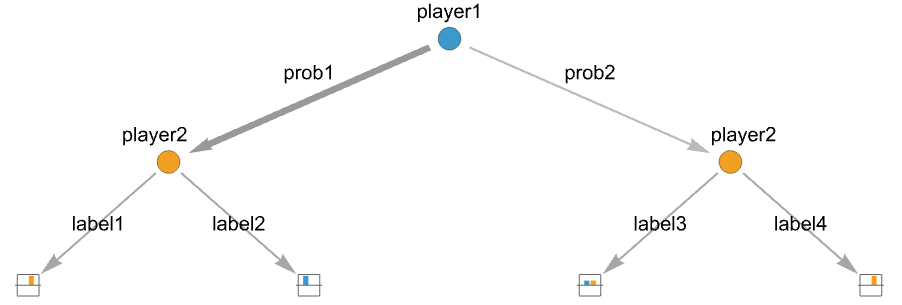Mathematica has functionality which enables extensive-form games to be constructed. It is possible to input probabilities onto edges, as shown in the second image in the Details and Options section on this page, and pasted below...

I can't quite figure out the semantics of this. It doesn't seem to be that of a chance node, since player1 (and not nature) is assigned the node prior to the edges with probabilities. It also shouldn't be strategic mixing, since game trees are typically constructed and stored (logically) prior to, and decoupled from, players' strategies. Indeed, there is other functionality which asks for a mixed strategy and a game tree as separate inputs (and checks whether the strategy is a subgame perfect equilibrium). And the edges with probabilities are not directed into the payoffs, so do not appear to be uncertainty about a player's type as in a Bayesian Game.
Am I correct in saying that this idea of a real player such as player1 making a choice into game tree edges with probabilities is absurd, or is there some other concept from game theory I'm not aware of being instantiated here?
- Additional information for action nodes include action labels and action probabilities:
{playerj,…,actioni->labeli,…} using labeli for actioni {playerj,…,actioni->probi,…} choosing actioni with probability probi {playerj,…,actioni->{labeli,probi},…} specify both label and probability - When using probabilistic actions at an action node, then all actions need to have probabilities for that action node.

I can't quite figure out the semantics of this. It doesn't seem to be that of a chance node, since player1 (and not nature) is assigned the node prior to the edges with probabilities. It also shouldn't be strategic mixing, since game trees are typically constructed and stored (logically) prior to, and decoupled from, players' strategies. Indeed, there is other functionality which asks for a mixed strategy and a game tree as separate inputs (and checks whether the strategy is a subgame perfect equilibrium). And the edges with probabilities are not directed into the payoffs, so do not appear to be uncertainty about a player's type as in a Bayesian Game.
Am I correct in saying that this idea of a real player such as player1 making a choice into game tree edges with probabilities is absurd, or is there some other concept from game theory I'm not aware of being instantiated here?
